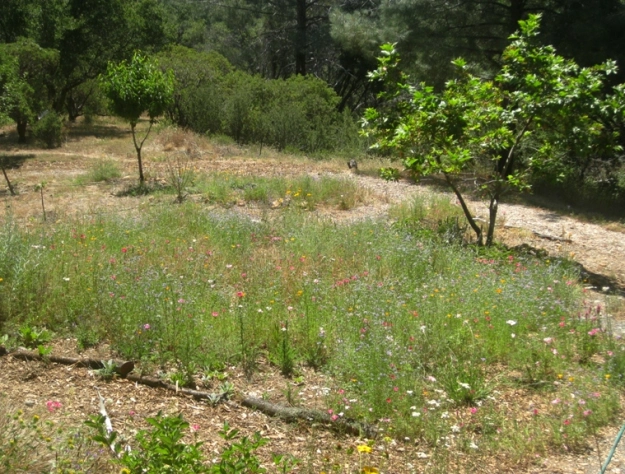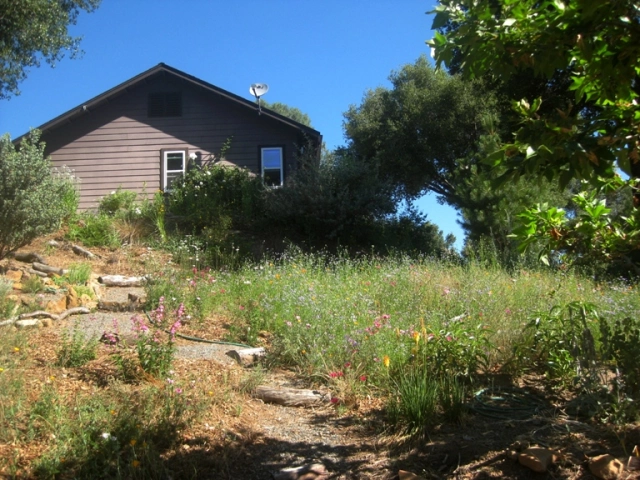My California native meadow in June
In Fall of last year, I became tired of a field full of Filaree and embarked on planting a beautiful meadow of native wildflowers and grasses. The Filaree stickers stick terribly to Maggie, our Corgi. Here are photos showing progress and challenges. June is when the pay-off for all hard work happens.
Here is the meadow at the end of June, with the Chinese Houses faded and the poppies still going strong. The stars for this month are the wonderful and new-to-me Globe Gilia and the flamboyant Clarkia amoena, as pretty and bright as any petunia.
The Sycamore is all leafed out after having been frozen in late snows. The Cherry tree at top left was also damaged enough in the cold that it has no cherries this year and now only presides over its own patch of wildflowers which spread downhill.
Maintenance and mulch
I’ve weeded around the edges, but only when I wander out there, (no big sweep through)… mostly finding odd grasses, field madder and bedstraw.
I’ve watered a bit in the hot mornings.
I’ve put logs along the upper edge to neaten and define it and I’ve mulched the path and the bare patches of ground in the middle of the meadow and around the edges, preparing for the hot summer. A nice long late-season rain this week has brought some welcome moisture. I’m delighted with that!
There are paths or steps on all sides and Tractor Man and I find ourselves walking this way with Maggie just to enjoy the color. There is so much to see, always something new, it seems.
Globe Gilia is not only tall, almost 3 feet high, but also full, having many branches and lots of buds. I’d consider sowing this in a swath elsewhere, after reading that it reseeds and germinates easily and seeing its fine ferny foliage. Being drought tolerant and butterfly attractors are two more benefits. What’s not to like?
You can see how the sea of Gilia rises above the meadow. Once the Clarkia started late this month, the color scheme has gone a little wild and circus like. I can imagine that this would be one reason for planting swathes of one type of seed; that might be more like Mother Nature paints these colors.
In the photo above you can see the drying seed heads of the Pacific fescue, Vulpia microstachys, which I sowed mostly in the center of the area. One disappointment has been no sign at all of the California Melic, Melica californica, California Barley, Hordeum brachyantherum or the Purple Needlegrass, Nassella pulcha that was supposed to be in the California Flowering Meadow Mix from S&S Seeds.
.
I hope I haven’t accidentally ‘weeded out’ the other grass seedlings, but what I did was try to ID the seedling first. One of my goals for the property is to identify native grasses, if they are here and plant and encourage more native grasses. Right now, I’m having trouble just identifying them, so not seeing three kinds included in the mix is discouraging!
At first the deer nibbled all the tops of this Gilia, and I was uncertain what would happen! It looks though, like they germinated so thickly that plenty were left to bloom and the deer have found, or learned that they’re not for them.
The Clarkia looks as if it has actually been painted with a brush.
The above photo was taken this morning, July 1st.
What’s next for the meadow
It looks like the July stars will be the Yarrow, Achillea millefolium, which is beginning to pop up above the meadow top and the Blue Flax linum lewisii, starting to fill out. The perennials, mostly penstemons and agastaches and Pink muhly grass, Muhlenbergia capillaris, around the edge will continue to to their job of anchoring the edges.
Notes: Do you want to see the beginning of this project? Here are all the previous posts:
The Meadow project, month by month
What am I really doing in the garden in October? Planning and removing weeds
Do you dream of a natural and beautiful wildflower meadow? Finding and sowing seeding
Let’s check for progress on the meadow! Weeding and watching the weather
How to weed a meadow in the Sierra Foothills More weeding…letting the sprouts thrive
Let’s check on Fall and Winter projects! Identifying seedlings
The wildflower meadow in May Small triumphs
My California native meadow in June Starting to bloom
The midsummer meadow The peak bloom
Stomping down the Autumn meadow Neatening up
Native California meadow in the second year
*There was a California native meadow project done at Yerba Buena Nursery in 2005. They have it organized in an easy to navigate week by week sequence with tips included so if you want more details, check it out.
More links:
S&S Seeds, Inc.
Carpinteria,CA
How to sow wildflower seeds article by Judith Larner
Wildflower FAQ by Wildseed Farms
Recent Posts
How to Be a Lazy Gardener
...and still have a pretty garden With a busy household and jobs, we are…
Summer is Spring at Whiskey Falls!
Take a day trip to Whiskey Falls... Come visit Whiskey Falls and the surrounding high…
California oak acorns: Feast or famine
Why do oaks drop more acorns some years and not others? If you have live…
Mule’s ear and Farewell to Spring
Roadside treasures worth stopping for In the first week of July in the Sierra foothills…
Our favorite butterfly plants
Wow! Butterflies love these plants! Grow any of these for instant results and each is…
A water-saving veggie garden for the foothills
Your water-wise veggie garden Does everyone in our Mountain Community grow at least one tomato?…


